Come winter and anglers become increasingly excited about ice fishing. Over the years, it has achieved comparable fan following as fly, trout, or bass fishing.
Ice fishing is not more dangerous than being out on the road (statistically), which causes more accidents and mishaps. It is even less dangerous than many common adventure sports out there, and with a little common sense and precaution, almost all dangers can be averted.
However, there are still many anglers like you and I who are skeptical of the dangers of ice fishing. This article will explore the common ice fishing dangers and how to tackle them smartly.
The Dangers Of Ice Fishing
While there are many dangers associated with ice fishing, as we have listed below, each of the dangers can easily be dealt with by taking proper precautions. Further, it is completely possible to eliminate each of these dangers in the first place entirely, and even if you are trapped in one of these situations, it is not that difficult to come out of them if you do not panic.
1. Falling Through Thin Ice
Falling through thin ice into the icy cold water is perhaps the first danger that comes to your mind when you think about ice fishing. It might even be the reason why you wanted to know whether or not ice fishing is dangerous.
But understand that, whether it is your foot getting stuck in an ice hole or you falling in completely, they are not the most common hazards. Many statistics like the study on Injury Patterns and Outcomes of Ice-Fishing in the United States reveal other mishaps (that we discuss later on) that are much more likely to occur.
However, these dangers and their consequences cannot be ignored. In fact, not only anglers are at risk of falling through the ice, but also ATV, trucks, ice fishing houses, and other vehicles that are used for ice fishing. These vehicles are heavy and put a lot of stress on the ice due to their weight.
And falling into the chilly water when you are trapped inside a vehicle is much more dangerous and difficult to deal with than when you are without a vehicle. However, keep in mind, even if you are fishing in normal waters, there is always a risk of falling in, so ice fishing is not extraordinary in that respect.
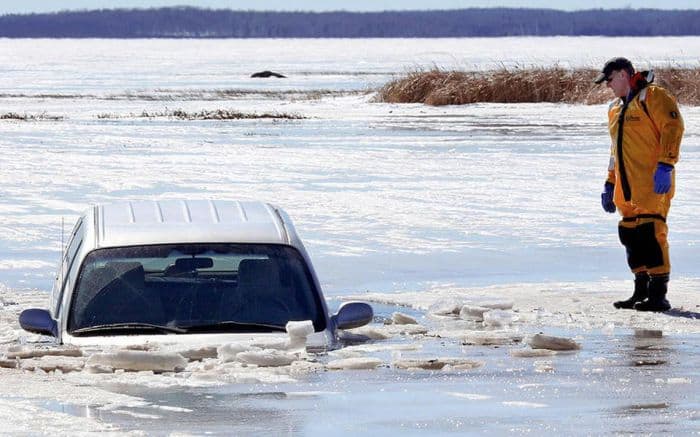
2. Carbon Monoxide Poisoning
After talking about the first danger that comes to mind, now let’s talk about the one that hardly crosses anyone’s mind. But you’ll be surprised to know that it is more common than falling through thin ice.
Many times, ice fishing enthusiasts use ice houses or makeshift shelters for a day or a few days at a stretch with some kind of internal heating system to keep them warm. When these systems aren’t installed correctly, or there is improper combustion of the gases, there is a considerable risk of dying due to the inhalation of carbon monoxide gas.
People die in their sleep due to suffocation as the body does not get enough oxygen. It isn’t as if you would be running around all teary-eyed and choking. You’ll die peacefully in your sleep and won’t have the faintest idea of what is happening to you. Yeah, that’s how dangerous carbon monoxide poisoning is.
3. Frostbite & Hypothermia
Since while ice fishing, you are bound to face sub-zero temperatures and harsh winds, therefore frostbite is expected. Even though it is not a fairly common occurrence as one would think, still, when a ‘cold thermal injury’ occurs, it is pretty nasty.
There have been cases where people had to get their finger or a toe amputated due to gangrene development after severe frostbite. Another occurrence is hypothermia, which can surface due to situations like prolonged exposure to cold, insufficient clothing, and the body remaining in contact with ice-cold water for several minutes at a stretch.
In hypothermia, your body is losing heat faster than it can produce, and the body temperature drops dangerously low from the standard 98.3 F to 95 F or lower. Thus, in essence, unsafe exposure to extremely low temperatures is the main culprit behind both frostbites and hypothermia while ice fishing and can be life-threatening.
4. Fires Due To Rudimentary Heating Systems
An added risk along with poisoning due to carbon monoxide is the risk of fires due to improper heating systems running on gases like propane. A spark is all it takes, and there is an endless disaster.
Also, a lot of times, there is alcohol lying around in these closed spaces, which only fuels the fire and makes the angler incapable of defending themselves if there was overconsumption of liquor.
Due to small spaces in these ice houses and shelters, not only the fire engulfs everything quickly, anglers have very little time to react and escape the smoke and fumes to avoid choking themselves to death.
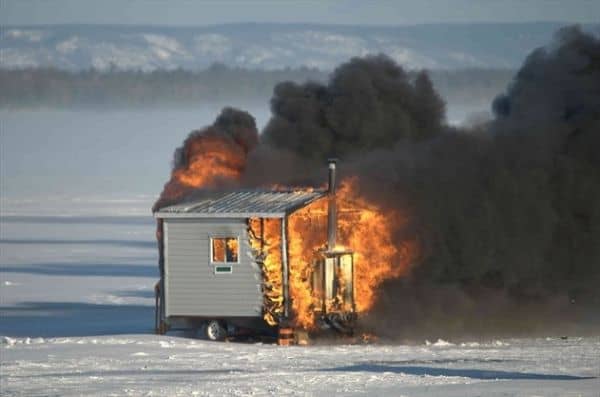
5. Fish Hook Injuries & Punctures
Like regular fishing, fish hook injuries and punctures occur a lot while ice fishing too. However, there is an added problem of our hands being numb due to bone-chilling temperatures. When your hands are numb, handling hooks becomes extremely difficult in the first place.
Secondly, due to this disoriented handling, there are high chances that when the sharp hook pricks your skin, you would not realize it immediately, and by the time you do, you’ll have a deep puncture on your finger. Such injuries are much more severe when you compare them to normal fishing and take a longer time to heal.
Oh, and by the way, not falling through the ice into the cold water, but this is one of the most common injuries statistically.
6. Falling ON The Ice
And finally, we address the most common mishap while ice fishing, i.e., falling on ice. When you are on a surface as slippery as ice, accidents are bound to happen.
The gravity of these injuries can be understood from the fact that when anglers have a hard fall, there are broken bones, teeth, nose, severe concussions, immobility, prolonged disorientation, and terrible traumas. And even in the best-case scenario that you don’t end up severely hurt, there are high chances of painful sprains or excruciating pain in general.
7. Cutting Yourself With A Running Auger
An instrument like an auger can be an ice fishing angler’s best friend to drill holes into the thick ice sheets. However, it can also become the cause of deep and severe cuts and injuries. Due to the extremely cold conditions, sometimes the hands become too numb to properly handle the auger or switch it off in time as it falls off our hands towards our legs.
Similarly, some ice anglers make the cold an excuse to overdrink and lose the motor capabilities to handle a dangerous instrument like the auger. Needles to say, the cuts are deep and result in a lot of blood loss.
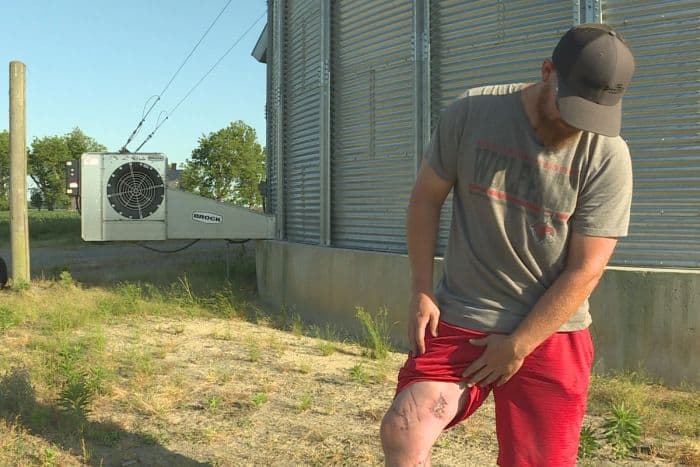
8. Weather Conditions
In several areas throughout the world, renowned ice fishing spots are also notorious for unstable weather conditions. What seems like a good time for ice fishing might become the path of a blizzard within an hour. Ice anglers are often caught unaware while they are leisurely fishing away, and by the time they realize, it is too late.
They are unable to strengthen their shelter in time or make proper arrangements to stay safe until the weather is favorable again. There have been cases where ice fishing enthusiasts were stranded in their makeshift shanties or on a floating mass of ice for several hours without food and heat. Only a fortunate few survive in such conditions.
How To Make Ice Fishing Less Dangerous?
In the following section, we will discuss how we can minimize or eliminate some of the dangers of ice fishing discussed above.
1. Assessing The Thickness Of Ice
Firstly, do NOT judge ice solely by the way it looks. Thickness is a much better measure, and even that is not foolproof, as we will discuss in the next section of this article along with the numbers to look for. But as a good rule of thumb, you can remember that clear ice is stronger than cloudy looking ice.
Also, if the ice has been newly formed, it holds better than the old ice. But as we had said, don’t go for appearances alone. Always carry an auger or spud with you, a metal chisel, and a measuring tape or stick. Tread cautiously around the ice while making small holes through a metal chisel.
Not being able to create a hole with a chisel is usually a good sign. These places are safe to drill a hole with the spud or auger. However, if you do manage to make a hole, finding out its depth is the next logical step. If you are in a vehicle, please make sure that you are checking the depth every 50 yards.
2. Preventing Monoxide Poisoning & Accidental Fires
When getting a heating system installed, make sure to go with a reputed company even if it is a bit more expensive than other options. Remember, it is a question of life and death here. Apart from that, there is peace of mind in knowing that you don’t need to worry about leaky gas pipes and faulty room heating systems.
If you are going for pre-built ice houses, make sure you do NOT choose cheap options and buy something which passes all the security checks. This goes a long way in preventing mishaps. Another tip is always to carry an extra fire extinguisher even if you don’t feel the need to do so. It is better to be safe than sorry.
A sound fire alarm system provides warnings and water sprinkling if you fail to detect smoke due to whatever reason.
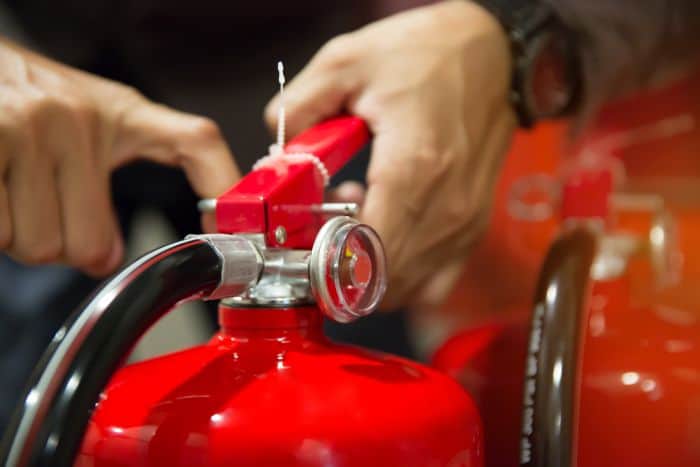
3. Dress In Layers Of Clothing
Just because you don’t ‘feel’ cold enough, it is a terrible idea not to wear protective clothing. Ensure that you cover yourself from head to toe in layers of clothing. Layers provide extreme protection as the gap between the layers traps the heat and acts as an insulator.
True that wearing multiple layers affects mobility a bit, however, you definitely wouldn’t want to lose your limbs due to frostbite or lose your life due to hypothermia. It is a much smarter choice to compromise a bit on mobility if you want to enjoy ice fishing for several years to come. A question might arise in your mind here.
What if you fall into the water? Won’t these layers of clothing work against you as all these clothes would become wet, cold, heavy, and pull you down into the water as you lose body heat more quickly? We will address this concern in point number 6.3
4. Do Not Wear Seat Belts On Vehicles
While this may seem like a controversial opinion, it can prove to be a lifesaver. In the case where your vehicle falls through thin ice into the water, you want to make sure that you can get out as soon as possible. Seat belts are an added step in this process with the danger of getting stuck.
Some drivers also like keeping the driver’s window and the vehicle’s door slightly open if they are moving on ice. Doing so gives them a clear route to escape. Needless to say, as you are driving around on ice and that too without a seat belt, limit your speed to no more than 20 mph.
Through slow speed, you can avoid forming any waves on the ice surface, resulting in the formation of cracks. Slow speed gives you more time to react. And in case you need to park, make sure your vehicle is at least 50 feet from other vehicles to spread the weight evenly.
5. Check What Type Of Ice You Are On
Ice color and conditions of formation might not be the standard for assessing ice quality in a standalone way, but it is an excellent measure when coupled with technical methods like measuring the depth with a tape. The first thing to remember is that the ice formed is not uniformly thick all across the body of water you are fishing on.
Ice is comparatively thin near the banks than in the middle since the ground dissipates heat. Further, if there are objects like a rock, fallen logs obstructing the formation of a plain sheet of ice, then the ice there will be thinner too. The time of the year also affects the quality and thickness.
If it is the beginning of the winter or the end of spring, ice is a lot softer, especially near the edges. It is structurally sound further out but not like it was in the middle of the winter. In terms of color, like we already told you, look for clear ice.
It is the strongest and forms when the temperature drops below 18° F (-8° C) and remains so for more than a couple of weeks. If it is translucent where you do not see things as clearly, consider that ice to be a bit weaker than the former type, especially when there is another layer of half-frozen ice below.
The worst and the thinnest form of ice you can be on is gray in color. It gets its color from the moving water below. More often than not, you’ll find such ice in early winters or extremely late springs due to rising temperatures and melting ice.
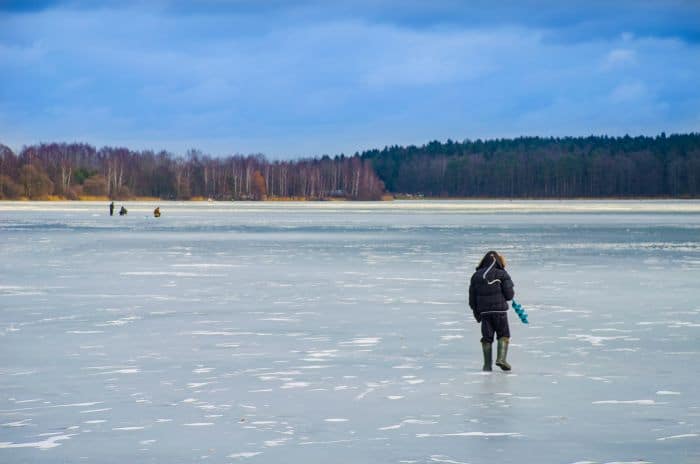
6. Arm Yourself With Safety Gear
What is it like to go into a war without any weapons? Suicidal right? So why would you not carry safety gear to minimize the dangers and maximize your chances of survival in case of accidents? Makes sense? Well, not to many ice anglers. Make sure you always carry the following items with you whenever and wherever you go ice fishing.
Remember, it is not for the ninety-nine times we take precautions when nothing happens. We do so for that one time when things go haywire.
6.1 Ice Claws
Ice claws consist of two sharp ice picks, each attached to a handgrip, connected by an extendable wire or rope. They are easy to carry as you can tie them around your arm, or wear it around your neck or waist, over your belt.
In the scenario you fall through the ice, these claws provide strong support that can help you come out of the water, which otherwise would be an arduous task due to your body temperature dropping every minute, which affects your strength.
6.2 Cleats & Throw Ropes
Ice cleats can be attached to your boots so that you have a firm grip while walking over the ice. This prevents accidental slipping and falling. Similarly, throw ropes are extremely useful for saving not only your life but also someone else’s.
Whenever you find yourself or another angler in water and under the threat of drowning, throw the free end of the rope to the other person. Pulling someone out this way can be a huge help as it reduces the effort required and gives them a lot of moral support that someone on the other end is there to save them.
6.3 Fishing Jacket & Floatation Suit
Buy an ice fishing jacket with in-built floatation features or get a floatation suit externally. Whatever the case, a floating suit is the most important thing that can save your life in water. Remember how you were concerned that wearing a lot of clothing in layers acts against you when you are trying to come out of the water?
Well, an ice fishing jacket will prevent cold water from drenching your clothes quickly, and a floatation suit will keep you above the water surface. Sometimes after a sudden fall, anglers take in a deep breath while gasping for air, which pushes cold water into their lungs. A floatation suit will not let your head go underwater.
Also, while anglers try to retrieve themselves using ice picks or through bare hands, ice keeps on cracking at the edges, which makes it impossible to get out until you reach a thick edge. Without a floatation suit, all this effort will tire you out quickly, and due to clothes filled with water, you’ll have absolutely no strength even to keep yourself afloat.
However, with a floatation suit, you can just relax for a few minutes and gather your strength before you try again. And do not worry, hypothermia does not set in immediately within minutes as anglers wrongly believe, and with the fishing jacket acting as a barrier between your body and cold water, it is further delayed.
You have a decent amount of time ranging from 30-60 minutes depending upon your body capacity in which you can not only come out but also warm yourself near a fire to restore the normal body temperature. Floatation suits are also vital if you consider the fact that sometimes you won’t be able to use your ice claws and throw ropes quickly.
A floatation suit will keep you afloat without costing any valuable energy until you can think of an exit plan or let other anglers come to your rescue.
6.4 Auger Blade Cover
Whether you are using a non-electric auger or an electric one, make sure that you always keep it covered when not in use. We have forgotten the count of the number of accidents that have taken place where the angler was either not paying attention or too drunk and accidentally cut themselves up.
More often than not, the blade cover that comes with your auger purchase wouldn’t be so good. Thus, make sure you buy one of good quality and thick material.
7. Never Go Alone
This is not something most anglers think of from a safety perspective. In case things go south, you’ll always have your friend or friends to work with you as a team and avert the danger asap. Yes, we can connect with people through the internet and cellular network with just a few taps, but nothing beats having immediate help at hand.
By the time you are able to spell out HELP or SOS on ice, your friend would throw you inside a truck and drive you off to safety. Ice fishing is safe and enjoyable, but it is even more so with your friends. Even for ice houses, you might feel like going out for a bit while the others wish to stay in.
Make sure that you are informing someone where you are going and by what time you will return.
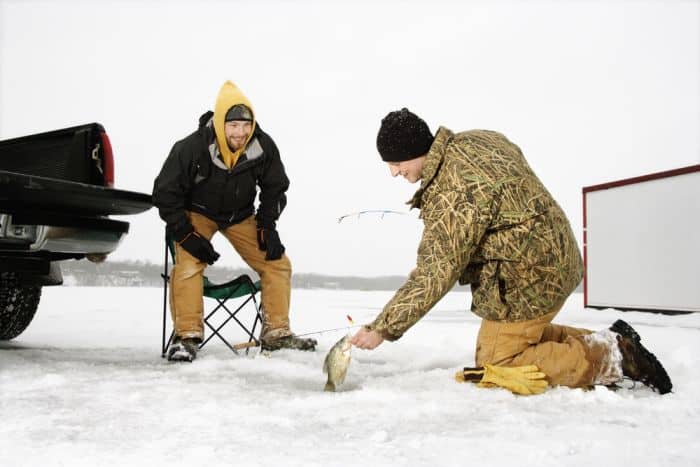
How Many Inches Of Ice Is Safe For Ice Fishing?
Before we even begin answering your question, whenever you are on the ice, always have the mindset that it is NOT safe. This will help you in staying alert for the slightest sign of danger. The following table will give you a rough estimate of the ice thickness to look for. However, do not treat these as the gold standard.
| Ice-Depth Safety | |
|---|---|
| When you are on feet | 4 inches of ice |
| For snowmobiles & quads | 6 inches of ice |
| When driving a small car | 7.5 inches of ice |
| For pickup trucks & mini vans | 12.5 inches of ice |
| For large trucks & RVs | 18 inches of ice |
A good way to assure yourself about the current ice conditions is to ask your local bait shop or the authorities in charge of the water body or resort where you are planning to fish. They can help you a lot in identifying the danger areas. And of course, another tool is your common sense.
Excessive fish activity, springs, pressure ridges, strong currents, and snow have a significant effect in thinning the ice cover. Fins of fishes swimming underneath brush the bottom of the ice cover quite regularly and weaken it. Similarly, strong currents contribute to the same through friction.
Also, snow deposits over moving water may look safe and hard enough from above, but it is dangerous to tread on. Prior knowledge about these conditions, either by doing your own research or by asking around, will go a long way in ensuring safety.
Conclusion
We sincerely hope that this article alleviated many fears you had regarding ice fishing and safety on ice. A lot of them can be dealt with easily, and most of the stories you’ve heard are most probably exaggerated versions of what happened and that too when the ice angler was not taking proper precautions.
We tried to separate the facts from folklore and fiction. Please write to us in case you have any suggestions, feedback, or something worth sharing related to your experiences with ice fishing.
